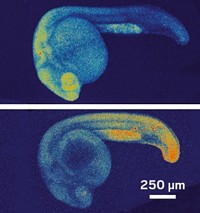Advertisement
Grab your lab coat. Let's get started
Welcome!
Welcome!
Create an account below to get 6 C&EN articles per month, receive newsletters and more - all free.
It seems this is your first time logging in online. Please enter the following information to continue.
As an ACS member you automatically get access to this site. All we need is few more details to create your reading experience.
Not you? Sign in with a different account.
Not you? Sign in with a different account.
ERROR 1
ERROR 1
ERROR 2
ERROR 2
ERROR 2
ERROR 2
ERROR 2
Password and Confirm password must match.
If you have an ACS member number, please enter it here so we can link this account to your membership. (optional)
ERROR 2
ACS values your privacy. By submitting your information, you are gaining access to C&EN and subscribing to our weekly newsletter. We use the information you provide to make your reading experience better, and we will never sell your data to third party members.
Biological Chemistry
Silencing Genes In Bacteria With The Help Of Their Neighbors
Method represses specific genes in bacteria by exploiting natural mode of microbial gene transfer
by Deirdre Lockwood
December 10, 2014

Broad-spectrum antibiotics have been lifesavers for decades, but their lack of selectivity can cause some problems. The drugs not only wipe out pathogenic bacteria, but also can kill beneficial ones. And widespread use of the antibiotics hastens the spread of resistance genes. Now a research team reports a synthetic biology method that could target problematic bacteria through a natural gene-swapping mechanism used by the microbes (ACS Synth. Biol. 2014, DOI: 10.1021/sb500036q).
The work started in 2013 as a summer project by undergraduates competing in the International Genetically Engineered Machine (iGEM) competition, a synthetic biology contest, says Kara J. Helmke, an education and outreach coordinator at the University of California, San Francisco. Helmke says the students had learned about a hot new gene regulation tool known as CRISPR interference. Biologists have used the tool to turn off genes selectively in human and mouse cells. Through discussions with collaborators, including Lei S. Qi at UCSF, who developed the tool, the students thought they could use it to attack bacteria selectively by turning off genes specific to pathogens.
The CRISPR interference system is a collection of genes that encode proteins and RNAs that do the actual silencing. When biologists have used the system, they have transferred these genes into their cells of choice in the lab. But in an infection, doctors wouldn’t have a good way to find the offending pathogenic bacteria to make the transfer. So the team, led by Helmke and Wendell A. Lim, decided to take advantage of a natural bacterial delivery gene-swapping system called conjugation. In conjugation, two bacterial cells link up through a tubelike structure called a pilus. The cells exchange DNA plasmids through this tube.
To test this strategy, the team designed an experiment with two strains of Escherichia coli, a donor and a recipient. The recipient strain included genes for two different fluorescent proteins that glow red and green, respectively. In the donor strain, the researchers introduced a plasmid containing genes that initiate bacterial conjugation. The plasmid also included genes for the two players in CRISPR interference: a protein and a short piece of RNA. The RNA has a sequence complementary to one associated with the gene to be silenced. It binds to the protein and guides it to the gene, allowing the protein to bind and block transcription. The team designed the RNA so that CRISPR interference would silence the gene encoding the red fluorescent protein.
The researchers incubated the donor and recipient strains together for eight hours and then measured the fluorescence of the recipient cells that underwent conjugation. The cells’ red glow was significantly dimmer than that of cells that hadn’t hung out with the donor cells—the intensity was 0.3% that of the control cells. In contrast, the intensity of the green glow in cells incubated with donor cells was 83% that of the controls.
Helmke says the results show how their system selectively silenced their target and not other genes in the recipient strain. The undergraduate team’s project made it to the 2013 iGEM world championships in Cambridge, Mass.
The strategy, Helmke says, could lead to selective antimicrobial therapies but would need to be optimized because of its low efficiency: Only 0.44% of recipient cells incubated with the donors received the CRISPR genes. Two recent studies have used bacteriophages as another means of delivering the CRISPR system to kill pathogenic bacteria (Nat. Biotechnol. 2014, DOI: 10.1038/nbt.3011 and 10.1038/nbt.3043).
“It’s a first step toward delivering CRISPR interference to reprogram natural populations of bacteria,” says Chase L. Beisel, a chemical engineer at North Carolina State University. Although the study provides a proof of concept, he says the delivery method should be tested in a natural bacterial community. Helmke says the team soon plans to try that experiment.





Join the conversation
Contact the reporter
Submit a Letter to the Editor for publication
Engage with us on Twitter